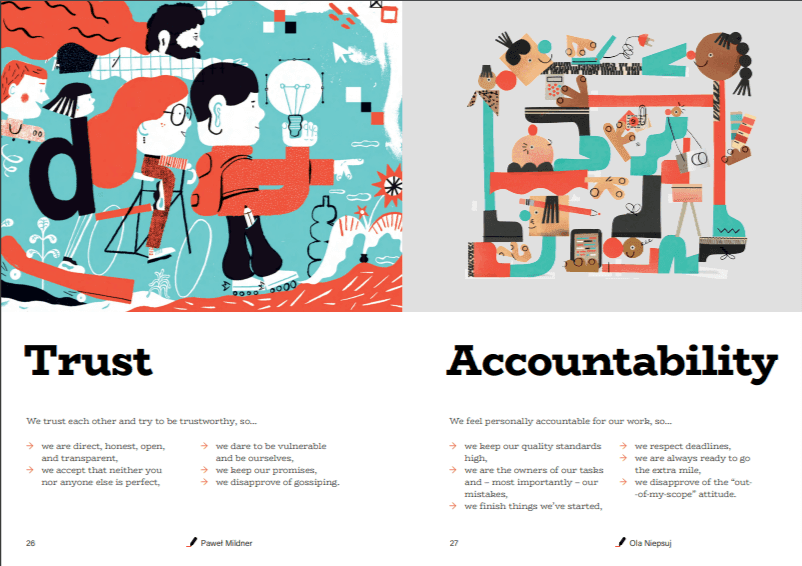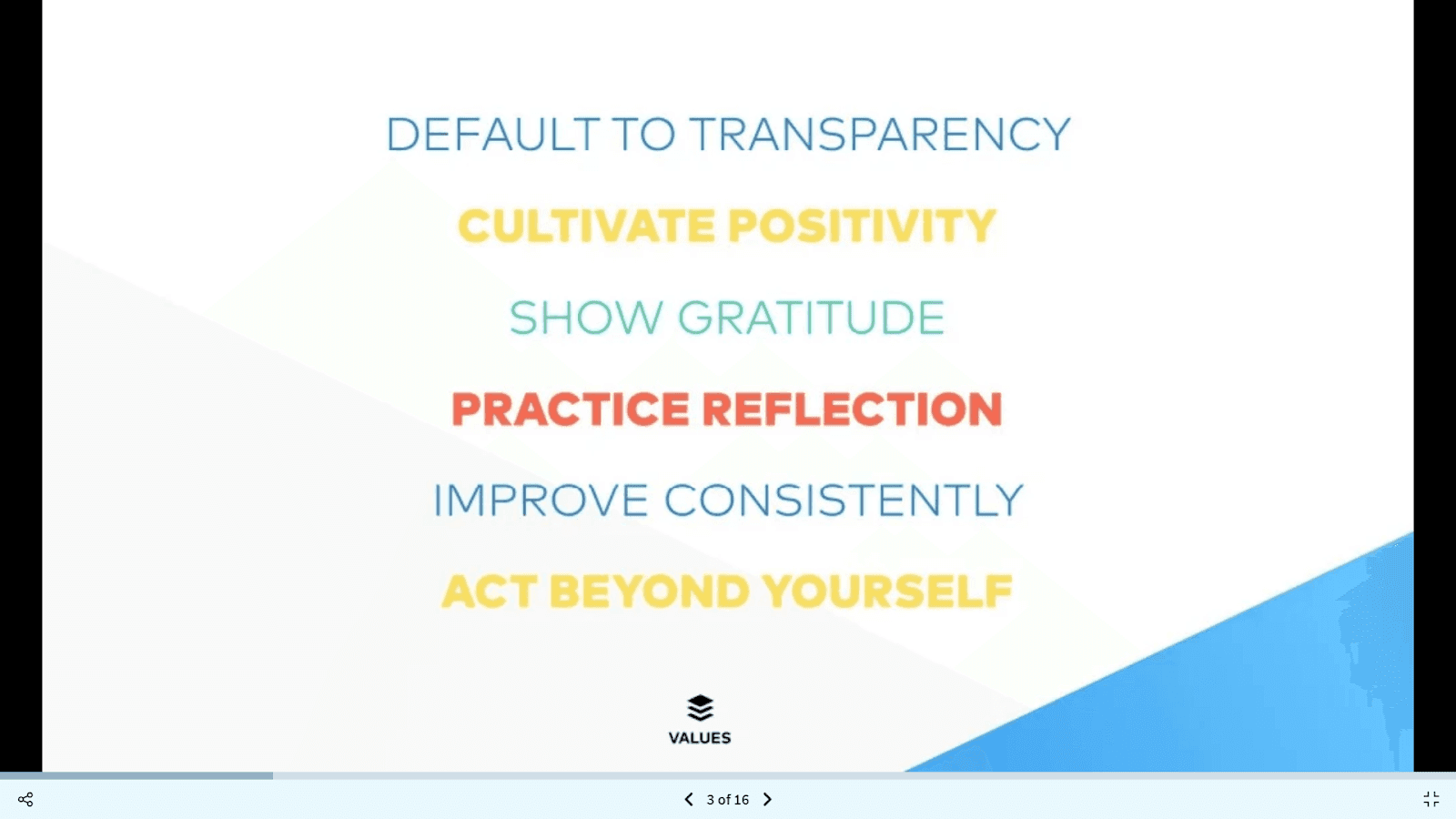Great company culture can be a strong motivator for your potential and existing team members.
The logic behind this is simple: if your company is known within your industry for its amazing culture and an engaged workforce, you’ll have no trouble attracting stellar talent to your company and retaining your team members.
Conversely, if creating a great company culture is not among your top priorities, chances are you’ll miss the opportunity to have top employees on board, and for that, you need a proper employee handbook.
That’s why we’ve gathered the best tips that will help you create a terrific culture deck for your company and build a culture you and your team members will be proud of.
Focus On Your Company’s Mission
Before creating a culture deck for your team, you need to define your culture.
This means knowing who you are as a company, why you exist and where you’re going. In other words, you need to understand what your company's mission is.
Therefore, your mission statement should stand proudly at the beginning of your culture deck so that all team members are clear about what the company stands for and hopes to achieve.
For example, Facebook defines its mission on the first important page of their culture handbook, right after the cover and table of contents.

Source: Facebook
By putting it front and center, Facebook acknowledged that it's aware of the mission statement’s importance for its culture.
As you can see, Facebook did a great job in summing up the company's very essence in the form of a mission statement. At the same time, many businesses may encounter difficulties in this field.
To describe what the company does is relatively easy, but capturing the vision and goals in a sentence or two may seem like a big undertaking.
However, you can ask yourself a few good questions that can help you define and create the perfect mission statement.
- What does your company do for your clients or customers?
- What makes your company unique?
- What core problem is your company trying to solve and, by doing so, improve the world?
By answering these questions, you will be able to get a much better picture of what lies at the very core of your business, thus making the task of defining your mission more manageable.
For instance, Starbucks CEO Howard Schultz was very fond of Italian espresso bars and wanted to create cozy coffee shops where people would stop on their way to and from work. At the time, such establishments existed only on college campuses.
Their mission statement perfectly reflects Schultz’s intentions, and it basically answers the first and third questions from our list.

Source: The Print Authority
Inspired mission statements like this will guide you and your team members in different decision-making situations and ensure that you all work towards a common goal.
Therefore, it’s crucial that, before everything else, you dig in and start creating a mission that will be the focal point of your overall culture deck.
Base the Culture Deck on Your Values
Once you define your mission, you should determine your core values.
While the mission is focused on what you want to achieve in the future, the core values show what your team members are guided by in their daily activities.
Core values may consist of just a few words that emphasize what is important to you and your team and how you strive to run an ethical business.
Or they may be elaborate sections explaining the beliefs that direct all team members in their day-to-day endeavors.
They can also be the combination of the two, as we can see from the example from the branding and communications company Admind.

Source: Admind
They start by outlining seven core beliefs and then go on to explain them further with several list items and creative illustrations.
On the previous page, they also explain why those values are essential for the company culture.
That way, they ensure all team members are on the same page when it comes to behavior and attitudes that are appreciated and expected in the company.
This example clearly shows that by setting up your core values early on, you will set the standard by which you will be guided in various aspects of your business, from hiring new people, through dealing with customers or clients, to strategic planning and decision making.
That’s why it’s important that your team members internalize your values. When faced with a situation where they have to make a decision, they can ask themselves if it’s in line with what the company stands for.
A great way to encourage employees to remember your values accurately is to use a mnemonic acronym method, as presented in the example from Grammarly below.

Source: Grammarly
They highlighted their five values by taking the initial letter of each value to make an acronym that reads: E. A. G. E. R.
Thus, they enabled their employees to remember their belief system more quickly and added another value to the list, expecting their employees to be eager in their work.
Grammarly does an outstanding job of ensuring all employees know exactly what values they should implement in their day-to-day operations. And this is an excellent practice to follow in creating your culture deck.
But remember, core values are not something you can just copy from someone else’s culture deck. There is no one-size-fits-all solution when it comes to guiding beliefs.
And while all these examples give us a handful of ideas, keep in mind that your company is unique, and your core values should represent what you stand for.
Think of the Culture Deck as Your Company’s Constitution
No matter if you’re an established company or a startup trying to find its way in the competitive world of business, you should have a solid culture deck in place.
Your culture permeates everything that the company does–from production, through marketing, and to customer service. In other words, as the culture deck represents the very foundations of your company, you can consider it its constitution.
However, since your culture is going to evolve along with your company, just like the constitution, you shouldn’t consider your deck over and done with after you finalize it.
Rather, you need to continually ensure that it is relevant and current and applies equally to all. That means checking and rewriting your culture deck periodically to ensure everything is updated.
For example, Disqus has built its culture on the care and benefits available to its employees. Among other things, Disqus offers massages and yoga to its employees.
The company is always broadening its list of benefits for employees, so it’s important for them to be able to make changes to their culture deck on a regular basis.

Source: Disqus
One way to keep your culture deck flexible is to store it on a cloud-based documentation software, such as Archbee.
Such documentation software enables users to create easy-to-navigate and searchable culture desks that will be hosted online, making them easily accessible by everyone at any time.

Source: Archbee.com
As culture desks serve as the company’s constitution, employees will appreciate being able to access it with just a few clicks any time they need insight into the essential aspects of the company’s culture.
Not to mention that they will develop a sense of trust because you provide them with key facts so transparently.
From everything stated in this section, it’s clear that you need to dedicate a lot of attention to your culture deck to make sure it covers all the important topics and that it continues to be relevant to your employees.
After all, it’s your company’s fundamental document, so it deserves special care.
Get Your Team Involved
If you want to make your culture deck even stronger and more engaging, you can always invite other team members to contribute to its creation.
If you create your culture deck by invoking a mission statement and listing values that have little or nothing to do with your company, you will never be able to integrate them into your business. As a result, they will be essentially irrelevant.
That’s why it’s crucial to ask your employees their candid opinions.
In return, you’ll get valuable insights and a broader picture of your culture deck and how grounded it is in the workplace environment and practices on the ground.
And that will help you, if necessary, to adjust and alter those beliefs and ideals and make your culture deck more valuable and relevant to the team.
For example, you can invite other team members to fill out surveys and report to what extent they use mission and core beliefs as guides in their daily challenges. Check out Buffer’s company values survey below as a good example.

Source: Buffer
Also, if you ask them to contribute and advise on improving your culture deck to make it more relatable, team members will identify with them more.
Let’s build on our last example with Buffer, the social media management platform.
They updated their culture deck twice. The first time they did it, they were more like a startup. However, the second time they implemented changes, it was five years later, when they had evolved and changed as a company, and their old values seemed to be less apparent to the team members.
While working on the new version, they interviewed 35 team members for six months, making about 200 pages of notes, 50,000+ words, and five drafts. Eventually, they came up with six values that best represent their company.

Source: Buffer
Buffer offers us an excellent example of how you can use the power of different perspectives to improve your company culture and the deck that reflects it.
As your business grows, it’s likely that your culture will also develop in a different direction from your starting point. So you will probably need to revise and update your culture deck eventually.
And to make this rather difficult task more manageable, you can rely on your team members. After all, they are the ones that will help you not only create a more well-rounded culture deck, but also implement it in the field.
Know That Real Culture Is in the Everyday
Today, the company's culture can't be defined by ping-pong tables, bean bags, free cakes for birthdays, and soda fridges.
Instead, if you want to have a really strong culture in your workplace, you have to focus on the people and make sure they live and breathe your mission and core beliefs in their everyday activities.
One of the most effective ways to build a strong culture among peers is to encourage team members to reward each other by recognizing each other's hard work and efforts.
This can be highly beneficial for creating a culture of collaboration among team members, as it shifts the employees' focus from trying to impress the boss to working for the team.
For example, Zappos doesn't leave any room for confusion when signaling that their top priority is building a culture where the team and family spirit are highly appreciated.
They put their Coworker Bonus Program front and center, allowing employees to award a fellow employee an extra $50 a month if they've gone the extra mile with their hard work.

Source: Financial Brand
By making happiness the core of their culture, Zappos doesn’t stop here to reward other team members.
They also encourage employees to nominate other coworkers for other rewards if they went above and beyond living by the company’s core values or if they have simply impressed other Zapponians by opening the door for them or cleaning the break room.
While Zappos managed to build a great culture that is recognized at every company level, from managers to customer support, many companies are still struggling to instill their values to the employees.
To achieve this, it’s vital to lead by example. You have to show your employees that you genuinely and enthusiastically live the company’s culture before you can expect others to follow your example.
This is especially important for the younger generations who weren’t raised with the belief that they need to sacrifice to achieve results and don’t consider burning out for the company a virtue.
Therefore, it’s necessary to show them that you genuinely believe in your culture and live and work by it if you expect team members to follow your lead in their day-to-day work activities.
That way, instead of imposing the company’s culture on employees, they will internalize it by following your example.
To conclude, if you want your culture to be more than just words on paper, find a way to make it permeate all aspects of your business.
Conclusion
We tried to emphasize what an enormous impact a good culture deck can have on your team’s happiness, performance, and overall satisfaction.
Additionally, implementing such guidelines will also attract like-minded candidates to come and work for your company, making the hiring and onboarding process much more manageable.
And if you incorporate the tips we’ve laid out in this post, chances are you’ll be able to create a great culture for your team in no time.
FAQ
Frequently Asked Questions
Because culture is a performance system, not office decor. A strong culture:
- Attracts and keeps high‑caliber people by signaling what it’s like to work with you.
- Boosts engagement and productivity by clarifying priorities, decision rights, and how work gets done.
- Improves decisions and customer experience through shared principles that guide trade‑offs.
- Lowers turnover and hiring costs while speeding up onboarding.
- Strengthens your employer brand and helps teams stay resilient during change.
Bottom line: culture turns strategy into consistent, everyday behavior.
